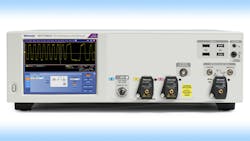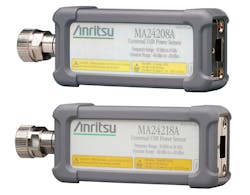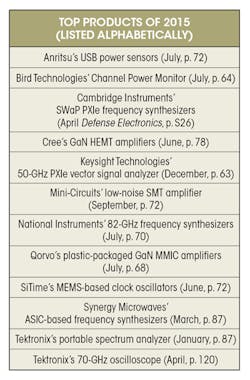Top Microwave & RF Products of 2015
This file type includes high resolution graphics and schematics when applicable.
Wireless communications continued to steer new product innovation and development in the high-frequency industry in 2015, as products from components and devices through test equipment were developed to enable improved communications capabilities. With the coming of the Internet of Things (IoT)—and potentially billions of wireless sensors contributing data to a huge “cloud” of computer networks and memory—wireless systems developers are searching for bandwidth and ways to move large amounts of data from one location to another.
In support of an increasingly wireless future, RF/microwave product developers demonstrated innovation without extravagance, achieving new performance levels that are affordable and reliable. The dozen products detailed here represent just a small sampling of the many excellent RF/microwave products introduced in 2015.
Interest in gallium-nitride (GaN) technology continued to grow in 2015 for both commercial and military users, as this high-power-density semiconductor substrate is helping to reach high output-power levels in smaller packages. To make those packages more affordable, Qorvo introduced a line of plastic-packaged GaN power transistors at 2015’s International Microwave Symposium (IMS), including the model TGF3015-SM with 11 W output power at 2.4 GHz. Housed in 3 × 3 mm plastic packages, the discrete transistors are usable from 30 MHz to 3 GHz
Click here for more on power transistors.
Certainly deserving of a “honorable mention” for a Top Product, Freescale Semiconductor introduced its model OM-270 plastic package at the same IMS event. It features GaN compatibility for commercial and military use.
Cree (now Wolfspeed) continued to challenge old-guard traveling-wave-tube (TWT) technology with its own GaN device introductions, including their model CMPA1D1E025 and CMPA1D1E030D Ku-band devices for satellite-communications (satcom) applications. The former is an impedance-matched GaN-on-SiC monolithic-microwave-integrated-circuit (MMIC) amplifier in a metal/ceramic package for use from 13.75 to 14.50 GHz (25 W output power), while the latter is a MMIC amplifier capable of 30 W output power from 13.5 to 14.5 GHz.
For systems where noise is a concern, Synergy Microwave Corp. introduced several versions of a phase-locked-oscillator (PLO) and frequency synthesizer combination in coaxial and surface-mount-technology (SMT) packages (Fig. 1). It uses a proprietary application-specific integrated circuit (ASIC) for wideband frequency tuning from 100 MHz to 15 GHz. The architecture has been used with different tunable oscillators, including dielectric resonator oscillators (DROs) and voltage-controlled oscillators (VCOs), with excellent results. These include spurious levels of -65 dBc or better and phase noise of -118 dBc/Hz offset 1 kHz from the carrier, and -123 dBc/Hz offset 10 kHz from the carrier. At 1 MHz from the carrier, the phase noise drops to a near-invisible -155 dBc/Hz.
Noise was also a key parameter in the design and development of the model PMA3-83LN+ low-noise amplifier (LNA) from Mini-Circuits, achieving low noise figures from 500 MHz to 8 GHz. It has a noise figure of about 1.5 dB at the lower-frequency end of the frequency range and slightly more than 2 dB at the upper frequency bandedge. The MMIC amplifier maintains flat gain of better than 21 dB across a wide operating temperature range (-40 to +85°C). It is packed into a 12-lead MCLP housing measuring just 3.00 × 3.00 × 0.89 mm.
In helping to evolve microelectromechanical-systems (MEMS) technology for use in such applications as the IoT, SiTime developed its model SiT8021 MEMS-based clock oscillator for frequencies from 1 to 26 MHz. The source is a fraction of the size and power consumption of traditional quartz crystal clock oscillators, and is well suited for mobile applications and wearable devices.
Smaller Test Gear
Test and measurement solutions continued to shrink in size and grow in capability in 2015, with the MA24208A and MA24218A USB power sensors from Anritsu Co. among the smallest of RF/microwave instruments—literally fitting in a pocket at 110 × 46 × 25.6 mm excluding the Type N connector (Fig. 2). The instruments cover 10 MHz to 8 GHz and 10 MHz to 18 GHz, respectively, using a patented triple-path architecture to deliver a power measurement range from -60 to +20 dBm with ±0.5 dB accuracy. For a reasonable cost, they bring power measurement capability to anyone with a personal computer (PC).
Power measurements for land-mobile radios (LMRs) are the specialty of the Channel Power Monitor introduced by Bird Technologies in 2015. The instrument monitors the transmission path of LMR systems from 144 to 960 MHz in real time (including police, fire, and emergency channels), with versions capable of handling power levels as high as 500 W CW. Standard units feature 16 channels, but can be readily expanded for more channels, fitting within a single 19-in. rack-mount enclosure (5.25 × 19.00 × 1.75 in.).
In test, as in 2014, manufacturers pursued the design and development of compact modular measurement instruments, such as the 50-GHz extension of the model PXIe vector signal analyzer (VSA) by Keysight Technologies detailed here. The frequency range of the M9393A VSA, a Top Product of 2014 (when the company was known as Agilent Technologies), was nearly doubled with the new frequency extension, providing precise signal analysis into the millimeter-wave range.
Cambridge Instruments aimed at excellent spectral purity from 6 to 12 GHz in its QuantumWave 4000 line of PXIe frequency synthesizers. Designed for applications requiring tight size, weight, and power (SWaP) requirements, the frequency synthesizers are suitable for a variety of military and aerospace applications. The typical phase noise is a low -145 dBc/Hz offset 10 kHz from the carrier.
Tektronix contributed to the trend in smaller, more powerful test instruments with its model DPO70000SX 70-GHz real-time oscilloscope (Fig. 3). It packs sampling rates to 200 GSamples/s into an instrument housing only 5.25 in. high, or about one-half the size of a traditional oscilloscope. The versatile oscilloscope can be used for single- or dual-channel measurements, and offers one or two 70-GHz-wide channels or four 33-GHz-wide channels. It employs patented asynchronous-time-interleaving (ATI) technology to digitize a wide spectrum using multiple, parallel signal paths, each with its own analog to digital converter (ADC). The component signal paths are tied together with the aid of an ATI ASIC.
Tektronix also brought the theme of smaller size to its RSA306 spectrum analyzer, a near pocket-sized instrument at 5.0 × 7.5 × 1.2 in. (127 × 190.5 × 30.5 mm) with a full-sized frequency range of 9 kHz to 6.2 GHz.
This file type includes high resolution graphics and schematics when applicable.
About the Author
Jack Browne
Technical Contributor
Jack Browne, Technical Contributor, has worked in technical publishing for over 30 years. He managed the content and production of three technical journals while at the American Institute of Physics, including Medical Physics and the Journal of Vacuum Science & Technology. He has been a Publisher and Editor for Penton Media, started the firm’s Wireless Symposium & Exhibition trade show in 1993, and currently serves as Technical Contributor for that company's Microwaves & RF magazine. Browne, who holds a BS in Mathematics from City College of New York and BA degrees in English and Philosophy from Fordham University, is a member of the IEEE.





